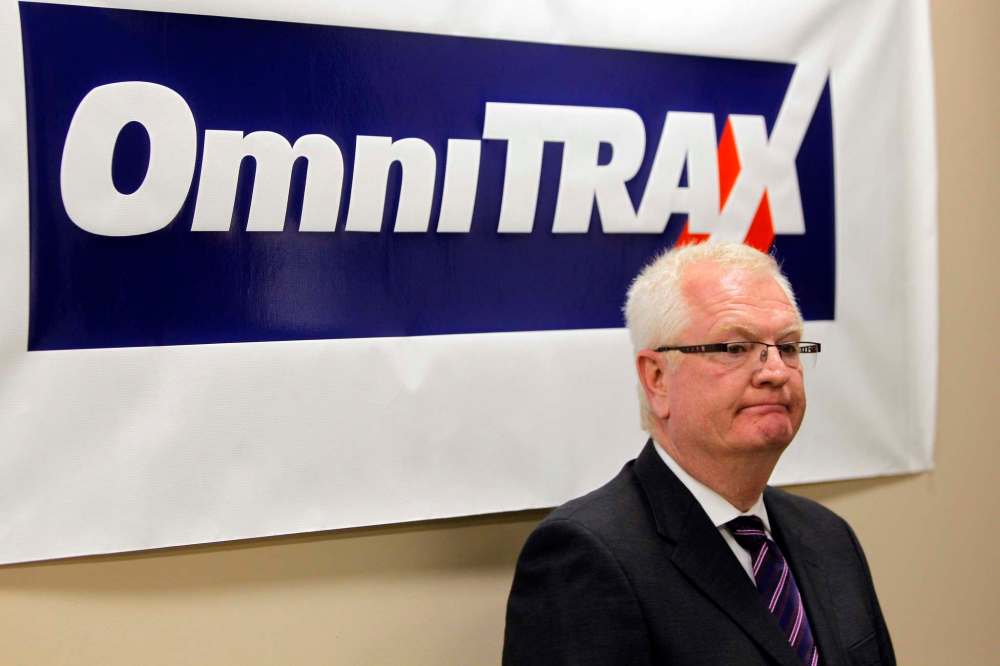Omnitrax tries to thwart federal lawsuit with name game
Advertisement
Read this article for free:
or
Already have an account? Log in here »
To continue reading, please subscribe:
Monthly Digital Subscription
$19 $0 for the first 4 weeks*
- Enjoy unlimited reading on winnipegfreepress.com
- Read the E-Edition, our digital replica newspaper
- Access News Break, our award-winning app
- Play interactive puzzles
*No charge for 4 weeks then billed as $19 every four weeks (new subscribers and qualified returning subscribers only). Cancel anytime.
Read unlimited articles for free today:
or
Already have an account? Log in here »
Hey there, time traveller!
This article was published 22/02/2018 (2253 days ago), so information in it may no longer be current.
OTTAWA — Omnitrax has again argued its Churchill railway subsidiary is a separate company, in a bid to have a judge toss Ottawa’s $18.8-million lawsuit against the firm.
Meanwhile, documents obtained through access-to-information suggest Omnitrax didn’t warn Transport Canada officials before publicly announcing the Hudson Bay Railway wouldn’t be running until 2018.
In May 2017, the railway between the northern Manitoba communities of Gillam and Churchill washed out, and its American owner, Denver-based Omnitrax, said it would not pay an estimated $43.5 million to restore the railway, as it is “not economically viable.”

Last November, the federal government filed a civil suit against both Omnitrax and its Hudson Bay Railway Company, seeking to claw back the $18.8 million Ottawa gave the firm under a 2008 agreement aimed at restoring the line, which contained clauses about needing keeping the railway operational.
According to documents filed in Winnipeg court this month, Omnitrax claimed it was a separate entity from HBRC, and there is “no cogent argument” it hasn’t fulfilled any contractual obligations.
On Feb. 14, the federal government reluctantly offered to strip the word “Omnitrax” from its November filing, but kept the substance of its allegations while attributing them solely to HBRC. That move delayed a court appearance scheduled for Thursday, until Feb. 27.
The nebulous dichotomy between Omnitrax and the HBRC emerged last month in front of the Canadian Transportation Agency, which is probing whether the railway was discontinued in breach of federal regulatory law.
The regulator rebuffed a similar attempt by Omnitrax to have the probe suspended on the basis of the HBRC being a separate company. The CTA noted manifold interviews where Omnitrax officials speak on behalf of the subsidiary.
On Thursday, Omnitrax’s Canadian head, Merv Tweed, dismissed the legal claim.
“This lawsuit does nothing to help facilitate a constructive solution for Churchill, and we believe it is a distraction from the work that needs to be done to enable the transfer and repair of the Hudson Bay Railway line,” he wrote. “Omnitrax Canada continues to work aggressively to arrive at a resolution that will allow for repairs to begin as soon as possible after the spring thaw.”
Meanwhile, internal Transport Canada documents suggest Omnitrax did not warn officials prior to announcing last June the railway likely couldn’t be fixed until spring 2018.
The company had already suspended rail service, but held a press conference to declare the railway wouldn’t be fixed by fall. That led bureaucrats to prioritize securing airport fuel for the looming winter.
Omnitrax also announced at that point it had commissioned engineering firm AECOM to assess damage along the line.
A month later, officials asked Omnitrax chief operating officer Sergio Sabatini for a briefing on that study. Sabatini instead suggested they could learn about some details during the July 18 stakeholder meeting.
A regional director suggested otherwise:
“From a regulatory perspective, we’d prefer the opportunity to sit and review AECOM’s work with you in a more thoughtful environment, where we could have some of our folks present to discuss things with you,” he wrote. “It would help clear up possible disagreements further down the line.”
Omnitrax would not say Thursday whether it briefed officials.
The exchanges also show Churchill’s town council was pondering asking Transport Canada to do “an assessment of the rail line, independent from the one that Omnitrax has done,” after photos taken within a month of the flooding showed most of the water had receded.
Internally, the department said Omnitrax made “an appropriate choice” in commissioning AECOM to study the line, and that it would be a conflict of interest for Transport officials to inspect and appraise the same railway it regulates.
In an email, the Town of Churchill confirmed it requested Ottawa “come up and see the damage for themselves.” It thanked the government for its ongoing talks aimed at transferring the railway and port into local hands, but added “the town has consistently believed there were quicker repair options available to restore service.”
The documents show that in June, the federal government designated Industry Canada as the lead department on the file, which has since bounced to Transport Canada and eventually Natural Resources, because it is led by Energy Minister Jim Carr.
They also show a handful of Transport Canada staff did a series of inspections during the first shipment of gas in July. Part of that required a last-minute, $4,500 flight which was paid for by the fund used for responding to accidents.
The official arrived during a rather warm day. “Hot here with lots of bugs, thank you for sending me up here,” he wrote.
— with files from Katie May
dylan.robertson@freepress.mb.ca


